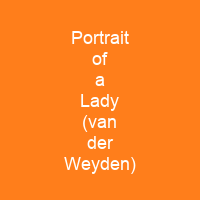Portrait of a Lady is a small oil-on-oak panel painting executed around 1460 by the Netherlandish painter Rogier van der Weyden. The painting has been in the National Gallery of Art in Washington, D. C. since its donation in 1937. It is the only known portrait of a woman accepted as an autograph work by van Der Weyden, yet the sitter’s name is not recorded and he did not title the work.
About Portrait of a Lady (van der Weyden) in brief

Her high headdress and severe hairline accentuate her elongated face, giving a sculpted appearance. The left ear is set, according to art historian Norbert Schneider, far,aturally high to her eyes rather than to her nose. In the 15th century, veils were normally worn for modesty, to hide the modesty of the flesh. In this work the veil has the opposite effect; the headdress to draw attention to her beauty and the face is framed by a small area of the picture. It has been described as “famous among all portraits of women of all schools”. The woman, who is probably in her late teens or early twenties, is shown half-length and in three-quarters profile, set against a two-dimensional interior background of deep blue-green. The background has darkened with age; it is likely that the angles created by the sitters’ henn in and dress were once much sharper. The flat setting allows the viewer to settle on the woman’s face and quiet self-possession. She is shown at a slight angle, but her pose is centred by the interlocked broad lines of arms, décolletage and veil. The woman’s head is delicately lit, leaving no strong tonal contrasts on her skin. It is not until Hans Memling, a pupil of van der weyden, that a Netherlandish artist set a portrait against an exterior or landscape.
You want to know more about Portrait of a Lady (van der Weyden)?
This page is based on the article Portrait of a Lady (van der Weyden) published in Wikipedia (as of Nov. 03, 2020) and was automatically summarized using artificial intelligence.







